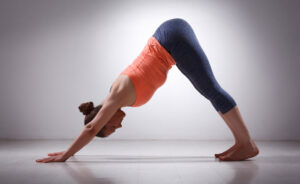Tadasana (Mountain Pose) Overview
On the surface, Tadasana or Mountain Pose appears simple – just standing upright with feet parallel, arms at your sides. But this foundational yoga posture contains profound depth when practiced with precision and mindfulness.
“From the outside, Mountain Pose looks extremely straightforward,” shares Stephany McMillan, founder of Rise and Flow Yoga. “Yet internally, one experiences an intricate dance of engaged muscles contrasted with areas of delicate softness and ease.”
This interplay between effort and surrender is central to yoga’s meditative essence. Tadasana teaches you to embody the key principles of alignment, muscle engagement, and mindful presence that facilitate deeper mind-body connection in more advanced asanas.
Recent research illuminates Tadasana’s wide-ranging benefits. A 2022 study found that consciously practicing Mountain Pose can significantly improve posture, core strength, and proprioceptive awareness. Regularly aligning the body in this integrated stance promotes balanced muscle engagement that counteracts the slumped, imbalanced patterns caused by prolonged sitting or technological device usage.
Moreover, Tadasana‘s emphasis on grounding, breath awareness, and a soft inward gaze is proven to reduce stress and anxiety. The pose naturally cultivates a centered presence that allows
the mind to settle. Many report feeling a sense of empowerment, stability, and confidence after holding this rooted yet uplifting posture.
So while outwardly simple, consciously embodying Tadasana lays the foundation for your entire yoga practice – both on and off the mat.
Sanskrit
Tadasana (tah-DAHS-ah-nah)
tada = mountain
asana = seat; posture
How to Do Mountain Pose
To enter Tadasana, begin by standing with your feet hip-width apart, bases of the big toes touching and heels slightly separated. Distribute your weight evenly across all four corners of each foot as you root down through the feet and legs.
Engage your thigh muscles to lift your kneecaps and avoid locking the knee joints. Gently tuck your tailbone towards the floor as you draw your lower abdomen inwards. This subtle inner lift helps elongate your spine into healthy extension.
On an inhalation, raise your chest towards the ceiling as your shoulder blades glide down your back away from the ears. Imagine a gentle upward traction from the crown of your head that stacks each vertebra into healthy alignment. At the same time, allow your arms to relax with soft bend in the elbows, palms facing forward.
Now bring your awareness to balancing effort with release. While still embodying vital muscle engagement, consciously soften areas of gripping or tension. Relax your facial muscles, jaw, tongue and the skin of your forehead and throat. Let your gaze settle in a soft, unfocused inward direction as you connect to your steady, smooth breath.
In this awake yet surrendered presence, you experience the essence of Tadasana. Your foundation is firmly rooted yet your heart lifts upwards in a buoyant ascending flow. As you integrate the pose’s refined alignment with an open quality of ease, the present moment reveals its radiant tranquility.
Beginners are encouraged to practice Tadasana frequently and patiently, allowing its deceptive simplicity to reveal profound insights into the art of wholehearted being.
The Power of Mountain Pose
While often overlooked as just a starting posture, Tadasana contains potent physical and energetic benefits that reveal themselves through dedicated practice. With regular embodiment, thispose can realign your entire being.
Physically, Tadasana strengthens the postural muscles that are key to avoiding back pain, poor posture, and other issues stemming from our modern sedentary lifestyles. “Drawing the shoulders back and down in this pose opens the chest and counteracts the hunched, defeated posture that saps our vitality,” explains Dr. Ray Long, author of Anatomy for Vinyasa Flow and Standing Poses.
The dynamic engagement of the legs, core, and back muscles also builds full-body strength, balance, and proprioceptive awareness. This integration is essential for safely practicing more advanced standing poses.
On a subtle level, Tadasana’s upright stance cultivates an inner sense of empowerment, self-assurance and presence. By consciously aligning with gravity’s grounding flow, you experience the stable power of being fully rooted in the present moment. At the same time, the elongating extension creates an elevated energy flow that instills confidence and poise.
This embodiment of steadiness and upliftment allows Tadasana to quell anxiety, boost mood, and increase focus. Many practitioners report feeling more resilient and capable after integrating this pose’s opening equilibrium.
Ultimately, Mountain Pose serves as a reminder to bring grounded presence into all of life’s experiences and everyday postures. As yoga instructor Alexandria Crow shares, “With a little conscious awareness, any moment can become a vitalizing version of Tadasana lived off the mat.”
Tadasana’s Evolution: Stepping into Your Practice
As a beginner, simply learning to stand with mindful alignment in Tadasana can be a revelatory practice. However, this seemingly basic pose contains infinite layers to explore as you evolve.
For example, you can bring your attention to different areas of engagement and release within the pose. One day, you may focus on rooting down through all four corners of each foot. Another day, sense the gentleuredvic lift of the perineum or play with varying degrees of soft belly engagement. The nuances are endless.
Your personal intentions and symbolic interpretations of the pose can also shift over time. Some days, Tadasana may represent a mountain of steadfast resilience. On others, it helps you reconnect with the grounded simplicity and humble presence we often lose in our busy lives.
As your practice deepens, you’ll discover Tadasana’s applicability off the mat. Its lessons about opposition and balance, effort and surrender, translate into meeting all of life’s experiences with an embodied equilibrium of equanimity and work.
By continuously evolving your relationship to this root posture, it serves as a constant yet evolving touchstone and reminder. “Tadasana is where we return to recalibrate, to sink back into bone, breath, and being,” reflects yoga teacher Dani Barclay. “It’s a posture we’re always practicing, always beginning again.”
Viewed through this lens, Tadasana reveals itself as much more than a neutral stance. It’s a symbolic portal, ever-inviting you to step wholeheartedly onto the path of yoga’s harmonic union. With patience and devoted practice, the mountain will unfurl its eternal, transformative wisdom.
The Anatomy of Mountain Pose
While appearing outwardly simple, Tadasana requires coordinated engagement of numerous muscle groups to achieve optimal alignment and integration. Understanding these anatomical patterns unlocks deeper levels of posture mastery.
At the core, the erector spinae muscles of the back body work in concert with the abdominal muscles in front to provide an uplifting extension along the spine. The rhomboids and middle/lower trapezius draw the shoulder blades into their natural position on the back plane.
In the legs, the quadriceps engage to lift the kneecaps as the calf muscles subtly fire to root the heels. The glutei and psoas muscles around the hips and pelvis must find their ideal balanced relationship – not gripping but not overly released.
Skeletal alignment is key, with proper stacking of the ankles, knees, hips and shoulders over the four-point foundation of the feet. The neck remains in neutral extension, with the crown lifting towards the ceiling.
However, Tadasana is not just about engagement – it’s a study in distributed tension and release. Areas like the facial muscles, jaw, tongue, and throat should remain soft and relaxed.
With practice, you begin to sense the interplay of agonist and antagonist muscle groups, the myofascial lines that integrate the whole structure, and the profound strength that comes from embracing steady ease.
This refined muscle awareness is not just pivotal for Tadasana itself, but translates into every posture. As Dr. Ray Long states, “From this asana, you can experience the correct form to all the others, if you consider the musculature involved.”
By embodying Tadasana’s nuanced anatomy, you open the door to accessing yoga’s highest potential for mind-body integration and presence. The mountain’s profound depths remain forever awaiting your exploration.
Tadasana’s Evolution: Stepping into Your Practice
As a beginner, simply learning to stand with mindful alignment in Tadasana can be a revelatory practice. However, this seemingly basic pose contains infinite layers to explore as you evolve.
For example, you can bring your attention to different areas of engagement and release within the pose. One day, you may focus on rooting down through all four corners of each foot. Another day, sense the gentle pelvic lift or play with varying degrees of soft belly engagement. The nuances are endless.
Your personal intentions and symbolic interpretations can also shift over time. Some days, Tadasana may represent an unwavering mountain of resilience. On others, it helps you reconnect with the grounded simplicity we often lose in our busy modern lives.
As your practice deepens, you’ll discover Tadasana’s applicability off the mat too. Its lessons about opposition and balance, effort and release, can be embodied when meeting all of life’s experiences. Innovative digital solutions like FlexifyMe‘s AI motion tracking platform can provide real-time guidance to integrate Tadasana’s principles into your daily movements and posture.
By continuously evolving your relationship to this root posture, it becomes a constant touchstone, reminding you to recalibrate and sink back into breath and being. “Tadasana is where we return, over and over, to begin again,” reflects yoga teacher Dani Barclay.
Viewed this way, Tadasana reveals itself as far more than a posture – it’s a symbolic portal, perpetually inviting you to step wholeheartedly onto the path of yoga’s union. With patience, devoted practice, and tools like FlexifyMe’s personalized programs, the mountain will unfurl its eternal wisdom for your journey.
Commonly Asked Questions for Mountain Pose (Tadasana)
What are the benefits of Mountain Pose(Tadasana) for body and mind?
The benefits of Mountain Pose(Tadasana) extend beyond physical alignment. As detailed by Harvard Health Publishing, it strengthens the thighs, knees, and ankles while improving posture. On a mental level, Tadasana fosters a sense of groundedness and balance. FlexifyMe highlights its role in improving focus and calmness, making it ideal for both body and mind rejuvenation. Regular practice can also help in stress reduction and increased awareness.
Is Mountain Pose(Tadasana) a good beginner yoga pose and how can I modify it?
Mountain Pose(Tadasana) is an excellent beginner yoga pose due to its simplicity and the foundation it provides for balance and alignment. Beginners can modify it by placing feet hip-width apart if balancing is difficult, as suggested by Yoga Basics. FlexifyMe advises beginners to focus on the sensation of the earth beneath their feet and the upright spine, enhancing mindfulness and body awareness.
What are common mistakes to avoid and tips for improving alignment in Mountain Pose(Tadasana)?
Common mistakes in Mountain Pose(Tadasana) include uneven weight distribution and slouching. Yoga International recommends evenly spreading your weight across both feet and engaging your core for proper alignment. FlexifyMe suggests regularly checking in with your body alignment during the pose, ensuring your shoulders are relaxed and your neck is long. These adjustments not only improve the pose but also enhance the overall benefits.
Why is Mountain Pose(Tadasana) important in yoga and how does it benefit other poses?
Mountain Pose(Tadasana) is crucial in yoga as it establishes the principles of alignment and balance. As per Yoga Journal, it is the foundation from which other standing poses evolve. FlexifyMe explains that mastering Tadasana improves posture and stability in more complex asanas, making it a cornerstone for yoga practice. Its benefits in improving posture and body awareness are essential for progressing in yoga.
Can I practice Mountain Pose(Tadasana) outside of yoga class and how often should I do it?
Absolutely! Mountain Pose(Tadasana) can be practiced anywhere, anytime. It's a simple yet powerful pose that can be integrated into daily routines. As suggested by FlexifyMe, practicing it for a few minutes daily can help maintain good posture and reduce tension. There's no set rule on frequency, but incorporating it regularly into your day can yield significant benefits.
What are questions and considerations regarding practicing Mountain Pose(Tadasana)?
When practicing Mountain Pose(Tadasana), consider your body's limitations and comfort. Questions to ask include: Am I distributing my weight evenly? Are my shoulders relaxed? FlexifyMe emphasizes listening to your body and adjusting the pose as needed, ensuring it feels right for you.
Are there risks or alternative poses for those who cannot do Mountain Pose(Tadasana)?
While Mountain Pose(Tadasana) is generally safe, those with balance issues or foot problems should take caution. Alternative poses include seated or chair variations, providing similar alignment benefits. FlexifyMe advises consulting with a yoga instructor or healthcare provider if you have specific concerns or health conditions.


